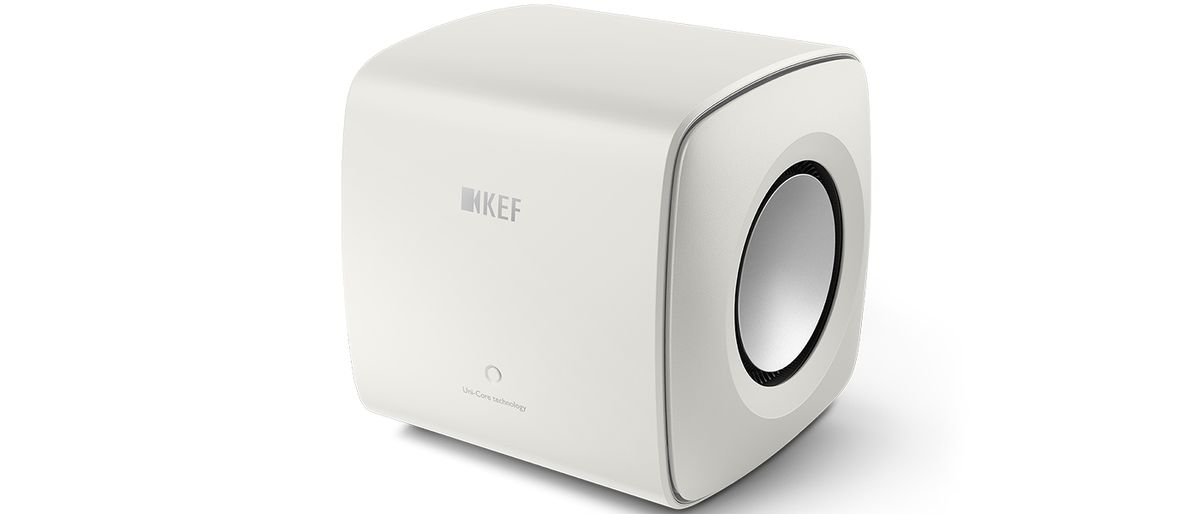What Hi-Fi? Verdict
While you'll certainly be paying a price for it, the KEF KC62 bends the laws of physics to offer incredibly powerful and clean bass for its tiny size – not to mention it comes in a compact and striking aluminium chassis and is very easy to set up.
Pros
- +
Tiny size
- +
Ease of positioning
- +
Bass for size
Cons
- -
Maximum sound pressure levels
- -
Awkward speaker level connections
Why you can trust What Hi-Fi?

This review and test originally appeared in Australian Hi-Fi magazine, one of What Hi-Fi?’s sister titles from Down Under. Click here for more information about Australian Hi-Fi, including links to buy individual digital editions and details on how best to subscribe.
The fact that KEF’s new KC62 subwoofer uses a force-cancelling driver array is not new or even news, because dozens of subwoofers use force-cancelling driver arrays. But it is true that it was once news – big news – because KEF was the first company in the world to build a commercial loudspeaker that employed force-cancelling drivers – the KEF Reference 104/2, way back in 1984.
What is totally new about the new KC62 – and also very newsworthy! – is that KEF has built a completely different kind of bass driver that has force-cancelling as an integral part of its mode of operation. So, whereas all other manufacturers use two separate drivers to achieve the force-cancelling function (as did KEF in 1984 with the 104/2 and in 2010 with the KC92), KEF delivers force-cancelling in this new KC62 using just a single driver, and a system it calls ‘Uni-Core.’
To the best of my knowledge, such a driver has never been built before: it’s completely new and totally different.
Uni-core bass driverKEF’s Uni-Core driver is an amazing device. Although it’s a single unit, with just one magnet and chassis, it has two voice-coils and two cones. Since this might be difficult to conceptualise (since to the best of my knowledge, this is the first time such a construction has ever been realised) readers would be best advised to look at Figure 1, below, which shows a cross-sectional view.
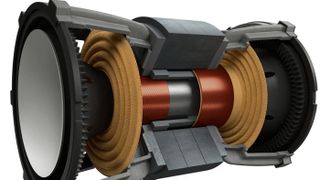
This cut-away view clearly shows that the two voice-coils, one with a greater diameter than the other, are arranged concentrically, so the smaller one operates within the larger one, and means that the voice coils are able to travel within their own gap(s) without colliding.
Obviously this means that the two voice coils must be different, and the magnetic fields in which they operate must also be different, yet in order for the force-cancelling to work, and for the acoustic output of the two cones to be identical, a great many electrical and magnetic parameters must have been manipulated in order to ensure this works as it should.
I must admit to being rather amazed that the Uni-Core driver works at all, or even that it was possible to FEA model the driver’s behaviour prior to building the first prototype. The primary issue is that that the magnetic field created in one voice coil by the alternating current flowing through it, which causes it to move in the fixed field created by the permanent magnet, would also affect the magnetic field of the other voice coil, and vice versa – and my initial thought that it would probably do this adversely.
KEF’s engineers obviously realised this straight away, and I suspect this is one of the main reasons a very comprehensive ‘White Paper’ has been posted on the company’s website that explains the operation of the driver. It turns out that KEF says it has eliminated interaction between the two coils by placing a large aluminium cylinder between them that acts as a low-resistance shorted-turn.
Not only this, but the cylinder apparently also dramatically drops the total inductance of the Uni-Core driver as well as reduces variations in inductance caused by the physical location(s) of the coil(s) in the fixed magnetic field, compared with a geometry where two completely separate drivers are used (as in, for example, the KEF KC92.)
This quite amazingly beneficial outcome is shown graphically in KEF’s White Paper, so I have included that graph below so you can be as amazed by it as I was.
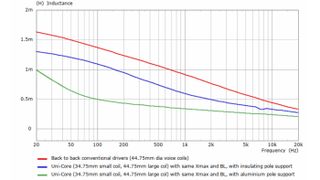
The graph above shows a completely unexpected result, but I guess that’s magnetism for you – it’s a strange force that in order to totally understand, you need to have a very good grasp on the principles of quantum mechanics.
And although things have progressed somewhat since Nobel Prize-winning physicist Richard Feynman said: “If you think you understand quantum mechanics, then you don’t”, I am still going with what Neils Bohr (also a Nobel prize-winning physicist) said, which is: “Anyone not shocked by quantum mechanics has not yet understood it.”
KEF’s White Paper also includes mention of Hofmann’s ‘Iron Law’, which is so important in the context of subwoofer design that I would like to discuss it in some detail, but if you’re not interested in the physics, feel free to skip the following section and move on to the heading ‘Construction.’
Hofmann’s iron law
All subwoofers have to conform to Hofmann’s Iron Law and the KEF KC62 is no exception however KEF’s White Paper states that “Iron Laws cannot be broken, but they can certainly be bent.” So I guess we should take a look at Hofmann’s Iron Law and how it applies to the KC62!
Hofmann’s so-called ‘law’ of low frequency reproduction was coined by Joseph Anton Hofmann, who was one of the three founders of KLH Loudspeakers, a company that in its hey-day was the largest loudspeaker manufacturer in the world.
In fact, the first letter of Hoffman’s surname is the ‘H’ in KLH. The other two initials were contributed by Henry Kloss (who helped found Acoustic Research before KLH and later founded Advent), and Malcolm Scollay Low (who had also helped found Acoustic Research and after leaving KLH would go on to found Evans and Sutherland Computer Corporation and become a pioneer in digital recording and computer graphics.)

It’s important to use Hofmann’s middle name because his father was none other than Josef Casimir Hofmann, one of the greatest pianists who has ever lived. And if that sentence made you stop in your tracks, consider that no less a pianist (and composer) than Sergei Rachmaninoff said Hofmann was the ‘greatest pianist alive’, Ralph Berkowitz said he “had the greatest technique of any pianist” he’d ever heard, and Anton Rubinstein thought that Hofmann was such “an unprecedented talent” that he took him on as a student – the only pianist he would ever teach.
On the merely ‘technical’ side, Josef Casimir Hofmann was also one of the first pianists ever to be recorded (on an Edison cylinder) and was also a prolific inventor, with more than 70 patents to his name, including patents for pneumatic shock absorbers for cars and airplanes, windscreen wipers, and a device to record dynamics in reproducing piano rolls (unfortunately invented just as piano roll companies went out of business). He also patented improvements to piano actions that were later incorporated into Steinway pianos.
His son Joseph Anton Hofmann’s “Iron Law” essentially states that three important attributes of any loudspeaker system are inextricably linked: low-bass reproduction, enclosure size and sensitivity (efficiency) in such a way that it is impossible for a single design to satisfactorily deliver all three.
He said that optimising any two of these attributes would inevitably compromise the one that remained. “A designer who wants good, deep low-frequency sound and high sensitivity can obtain these goals, but they will have to use a large speaker enclosure,” he said. “Similarly, if a designer is forced by space constraints to use a very small cabinet, and they aim to get good, deep low-frequency sound, sensitivity will inevitably be compromised.”
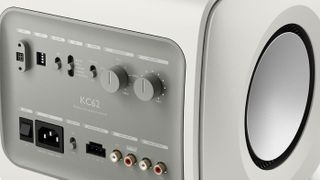
It’s really a variation of an old business adage, one that’s so well-known you’ve probably seen it on a sign in a business in your neighbourhood: “We offer three kinds of service: Good – Cheap – Fast. You can pick any two.” Meaning that if it’s fast and good, it won’t be cheap. If it’s fast and cheap, it won’t be good. And, of course, if it’s good and cheap, it won’t be fast.
If you studied project management at college, you probably learned these principles as the ‘triple constraints’ of any project: time, cost, and its scope or quality.
Of the three variables in Hofmann’s Iron Law, the one that’s the hardest to bend is the one that involves ‘good, deep, low-frequency sound.’ This is because of a very basic law of physics which states that if a bass driver can produce a sound pressure level of 90dBSPL at a frequency of 50Hz by moving back and forwards a particular distance (say, x), then for that same driver to produce 90dBSPL at 25Hz, the cone would need to move backwards and forwards a distance of 4x.
That is, when the frequency is halved, cone excursion must be increased FOUR times (not two, as you might have guessed).
The factor of 4 comes about because sound pressure is a result of a cone’s acceleration. So it’s the rate of change of its velocity. The rate of change of a sine wave increases with its frequency: the faster it oscillates, the more change. So the rate of change of excursion (i.e. velocity) increases with frequency of oscillation. Half the frequency also halves the rate of change. Acceleration is the rate of change of rate of change, hence the factor of 4.
The problem for a typical cone speaker is that a good Xmax for a high-quality bass driver would be about 10mm. So if it were using this Xmax to deliver a 50Hz signal at, say, 90dBSPL, it would need to travel 40mm in order to deliver exactly the same SPL at 25Hz. Clearly impossible.
If, on the other hand, you decide to use the driver’s Xmax to deliver a signal at 25Hz, this means that in order for the response to be flat down to this frequency, the cone will only move 2.5mm at 50Hz. This won’t be very loud at all. So you can get flat response between 50Hz and 25Hz, but only if you accept that undistorted sound pressure levels will be compromised.
So, in the words of KEF’s White Paper: “When designing a small subwoofer, the choice has to be made between high efficiency and low frequency extension. Both are very desirable features for a subwoofer. To create a subwoofer that can deliver the maximum performance for the minimum of space, KEF R&D worked to push the compromises as far as possible. After all, Iron Laws cannot be broken, but they can certainly be bent.”
Construction
The surround of the Uni-Core driver is a new one for KEF, which it calls ‘P-Flex.’ It was invented to solve a problem that affects all small subwoofers with sealed enclosures. And that’s the same problem no matter how many drivers might be fitted to the enclosure. That problem is that whenever the driver cone(s) moves ‘inwards’ the air pressure inside the cabinet will increase. Whenever it moves ‘outwards’ the air pressure inside the cabinet will decrease. Either way, the air pressure in the listening room will remain a constant.
The problem here is that the natural way of things is that nature would prefer it if the air inside the cabinet were at the same pressure as the air in the room, so it will attempt to equalise the two pressures. It can’t do this because the cabinet is sealed, so it will look for the ‘weakest link’ in the cabinet, which is the roll surround, and therefore will exert considerable pressure on this surround with the result that the surround will deform and no longer act in a linear manner.
In the past, the solution to this problem has been to increase the thickness of the surround to make it so strong it cannot buckle under the pressure generated, but this has two problems. The first is that the thicker the surround, the more energy needs to be exerted by the magnet/voice-coil in order to make the cone move, which reduces overall efficiency. The second problem is that the increase in the stiffness of the surround reduces the low-frequency response of the driver, which is the exact opposite of what you want to happen in a subwoofer.
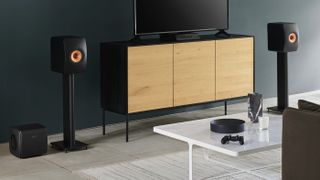
KEF’s ‘P-Flex’ surround, for which the company has applied for a patent, has ‘pleats’ in the roll that, to use the exact wording in KEF’s ‘White Paper’ “resist the deformation caused by the changing internal air pressure of the cabinet, whilst allowing extended, linear movement of the driver, without the issue of buckling at higher excursion.”
Interestingly, surround technology is going through something of a renaissance at the moment, possibly because of improvements in materials, moulding technologies and the increased use of Finite Element Analysis (FEA) in loudspeaker development so many different manufacturers are releasing drivers with unique surround profiles.
KEF’s P-Flex is as exciting a development as Purifi’s ‘Neutral Surround’ surround material, whose effective radiation area remains constant throughout the entire voice coil excursion. (Which solves the problem that affects traditional half-roll surrounds, which is that the radiation area decreases during ‘inward’ cone movement and increases during ‘outward’ cone movement.)
Interestingly, two of the inventors of the ‘Neutral Surround’ – Lars Risbo and Bruno Putzeys – are referenced in KEF’s ‘White Paper’, but not in relation to the P-Flex surround but instead to a paper they co-authored titled ‘Force Factor Modulation in ElectroDynamic Loudspeakers’, which was presented at the 141st meeting of the Audio Engineering Society Convention.
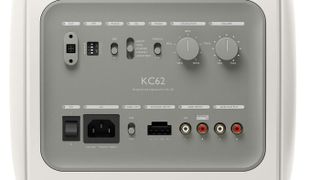
The fit ‘n finish of the control/connection plate fitted to the rear of the KEF KC62 is astoundingly good. It simply oozes quality. At the very top of the plate is an ‘Expansion Port’ that allows customers to add features they might like by plugging in optional devices.
The first of these to become available was the ability to send audio signals to the KEF KC62 wirelessly, which is made possible only by means of purchasing a separately available wireless kit (KW-1). This kit also allows you to interface the KC62 with other compatible KEF products, such as powered speakers… although you can already do this, as we will discover later in this review.
Immediately alongside this Expansion Port is a vertically-arrayed set of four DIP switches (DIP stands for “dual in-line package”) that are used to set the filter characteristics for the line output terminals of the KC62 (the terminals are located at the bottom right of the control/connection plate).
The available turnover frequencies for this filter are 40Hz, 45Hz, 50Hz, 55Hz, 60Hz, 70Hz, 80Hz, 90Hz, 100Hz, 110Hz and 120Hz. You can also use certain of the DIP switch settings to force the output to be mono, rather than its default of stereo.
To the right of the DIP switch is a simple two-position slider switch for phase (0° or 180°) and to the right of this is a five position ‘EQ’ slider switch with positions (from top to bottom) for ‘Room’, ‘Wall’, ‘Corner’, ‘Cabinet’ and ‘Apartment’.
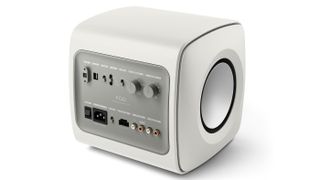
The reason for KEF including an Equalisation switch is that a subwoofer’s output volume is affected more dramatically by where it is positioned in your room relative to the walls, floor and ceiling than any other type of loudspeaker, due to the wavelength of the frequencies it’s reproducing being longer than those of ordinary loudspeakers.
(The lower the frequency of any sound, the longer the wavelength. A 170Hz sound has a wavelength of two metres, while a 17Hz sound has a wavelength of 20 metres.) KEF’s EQ settings allow you to adjust its output to ensure the KC62 will deliver its best performance no matter where in the room you end up putting it… even if you put it inside a cabinet.
But while the Room, Wall, Corner and Cabinet modes are self-explanatory, what about that ‘Apartment’ mode? What’s this for? Glad you asked…
Because of their long wavelength, low frequencies are far better at travelling through walls than higher frequencies, which tend to be reflected from hard surfaces, so if you live in a home unit, or a flat or an apartment (and, in the same manner as quantum physics, it must be said that only real estate agents know the difference between these three types of dwelling!), there’s an excellent chance that your neighbours will be also be enjoying (or not!) the low-frequency sounds made by your subwoofer even more loudly than you are in your own apartment.
So if you are using the KEF KC62 in an apartment, setting its EQ switch to ‘Apartment’ mode will increasingly reduce the volume level of low frequencies as they get lower in frequency, starting at 40Hz. So the further the frequencies fall below 40Hz, the more the KC62 will reduce their level.
Of course this won’t only reduce the chance of your neighbours hearing these frequencies – it will also reduce the volume levels in your own room, so that you may not be able to hear them as well either. So although such a switch might obviously be very useful at maintaining neighbourhood harmony, it does seem to defeat the reason for buying a subwoofer in the first place!
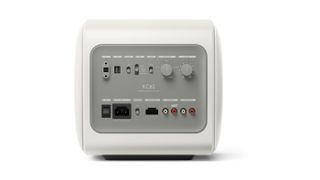
To the right of the Mode switch is another two-position slider switch, with the upper position labelled ‘Manual’ and the lower position ‘LFE’. When this is set to ‘Manual’ the rotary ‘Crossover’ control to its right becomes active, and allows you to set the high-frequency roll-off to best-suit your main speakers. It’s a rotary control with calibrated positions at 10Hz intervals from 40Hz up to 100Hz, after which there’s one calibration at 125Hz and a final one at 150Hz.
When the ‘Mode’ switch control is set to its LFE (Low Frequency Effects) lower position, the ‘Crossover’ control is disabled, so that the highest frequency the CD62 is able to deliver is instead controlled by your AV receiver’s LFE output. Since this is effectively a ‘Bypass’ circuit, if your AV receiver doesn’t filter its LFE output, the KC62 will operate ‘full range.’
The KEF KC62 has both speaker level (high) and line-level inputs, but the speaker-level inputs are not the usual large multi-way binding posts. KEF has instead provided a custom four-pin plug to which you connect your speaker wires, and it’s this plug which then connects to the small rectangular socket on the control/connection plate.
This makes for a very neat installation, but does rather limit you to using speaker wire diameters that will actually fit into the connector. So you may instead prefer to connect the KC62 using the line-level inputs which are provided in the form of two standard gold-plated RCA terminals, the left-most of which is for LFE connection and is so labelled. The right most RCA terminal is labelled ‘Smart Connect’. For connection to a preamp or similar, you’d use both terminals.
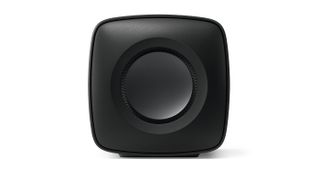
To the right of the LFE/Smart-Connect inputs is the pair of line-level outputs I mentioned earlier in this review. These can be set so the audio signals that appear there are simply a ‘loop-through’ from the line-level inputs, or you can route the audio signals through a high-pass filter (set by the DIP switch) to remove low frequencies before they appear at this output.
The main power switch is obviously wired to make sense to owners in the USA, because pressing the top of it inwards switches the subwoofer on (the exactly opposite of mains power switch operation here in Australia and in the UK). There’s a small tell-tale dual-colour LED above the switch that glows red when the subwoofer is off but power is available and green when it’s operational.
The KEF KC62 is available in one or the other of two colours – ‘carbon black’ and ‘mineral white’. Either way, it will weigh 14kg, which is amazingly heavy when you consider how tiny it is, at just 246×256×248mm. That’s barely bigger than the proverbial shoe-box!
Power and distortion
The KC62 has two Class-D amplifiers inside – one amplifier for each voice-coil – with each amplifier rated at 500-watts, for a total power of 1,000-watts! A great deal of this power is used just getting the cones to move because, since the KC62 enclosure is sealed and has a volume of only a few litres, a great deal energy is expended simply forcing the driver cones to move and alternately compress and rarefy the air inside the enclosure.
However, despite this, the 1,000-watts on tap is still more than sufficient power to push the cones beyond their most linear excursion point, at which point distortion would increase considerably.
To prevent this from happening, KEF includes its so-called ‘Smart Distortion Control Technology (SDCT) in the KC62’s circuitry to make sure the cones do not go beyond this point. Rather than use a physical sensor to monitor cone excursion, KEF instead uses a current sensor to directly and instantaneously monitor the current flowing in the voice coil. When the current being drawn indicates that distortion has increased, drive voltage to the voice-coil is instantly reduced. But KEF’s SDCT circuit is not only reactive, it is also proactive.
KEF uses a digital signal processor to modify the audio signal delivered to the driver to ‘pre-compensate’ for known limitations of the Uni-Core driver’s operational parameters, effectively ‘pre-correcting’ for distortion that would otherwise be introduced by the driver (some of which could be a function of the geometry of the unique driver itself, as discussed previously).
The DSP circuitry works in concert with the current-sensing circuitry in such a way that KEF claims the combination of these technologies reduces THD by up to 75 per cent (below 50Hz).
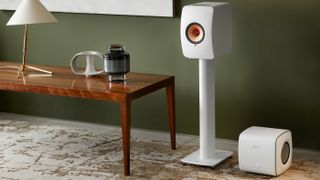
Listening sessions
Despite the welcome inclusion of equalisation circuitry to compensate for room position, you will still get best performance if you position the KEF in the place in your room where it is the best acoustic match with your room. (Which is true of all subwoofers, but becomes increasingly important as the subwoofer gets smaller in size.)
To establish the best position, place the KC62 where your head would be when you’re listening to your system (which is particularly easy to do since it’s so small!) and then, when using some music with deep bass on an A–B loop, crawl around your room. At some points you’ll hear quite loud bass and at other points you’ll hear very little bass at all.
Pick one of the points where the bass was loud and put the KC62 there. After that, set the EQ switch to the setting that best reflects this location or, using the same A–B bass loop, sit in your listening position and have someone else switch through the different EQ settings and choose the one whose balance you most prefer.
I started my sessions with the KC62 with one of my favourite albums, obviously because of the music, but mostly because of the lovely walking bass lines, from which the album (Quincy Jones’ ‘Walking in Space’) does not actually take its name.
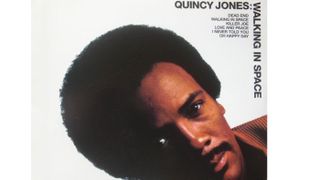
Right from the very first track, Dead End, I could hear the KEF ‘doin’ its stuff’ and really fleshing out the Ray Brown’s double-bass. That ‘distortion’ you can hear at the end is not the KEF, by the way, it’s recorded.
The KEF continued to impress with the title track, plus there’s the kick drum sound as well. The justifiably famous Killer Joe, let the KC62 shine too, but it’s Love and Peace that perhaps showed its talents to the greatest degree, as well as demonstrating how well the subwoofer integrates with the main speakers – there’s really no confusion at all at the point of acoustic crossover.
If you’d like to hear the KC62 perform with electric bass, you won’t have a better demo track than Whole Lotta Love from Led Zeppelin II, with John Paul Jones on the fret board and John Bonham on drums. The truly great bass riff and the insane drumming were delivered marvellously well by the KEF KC62.

I checked the speed of the KEF KC62’s bass with Michael Jackson’s Wanna Be Starting Something, the opener on his fantastic album ‘Thriller’. The video clip for the title track is still one of my all-time favourite clips. (Actually, thinking about it, I think it is the best I’ve ever seen). This would be a good track for your crawl-around, by the way.
The KEF was impressively fast – didn’t miss a trick, actually. I wasn’t sure if the KC62 could deliver the subterranean deep bass FX on Beat It, but it proved it could… as well as the authentic instrumental bass lines. All this great performance comes with one proviso, which is that it’s most impressive at lower listening levels, and becomes less so as you wind up the volume. The KEF KC62 is certainly great at producing a rabbit out of the hat, but not a kangaroo! Equally, its bass is more impressive in small to average-sized rooms than it is in larger ones.
Verdict
One aspect of the KC62’s performance that KEF’s ‘White Paper’ does not mention when it’s talking about ‘Iron Laws’ is that ‘bending laws’ costs money! And the additional costs involved in doing that are considerable and clearly evidenced in the build quality required in order to enable the KC62 to deliver the high levels of performance that it does.
For example the KEF KC62 has to have an expensive aluminium cabinet to withstand the high pressures involved, rather than an inexpensive wooden one. It also has to have two enormously powerful amplifiers inside, rather than a single less powerful one.
It also has to have an extremely complex, very difficult-to-build ‘Uni-Core’ driver inside, rather than two ordinary drivers. Plus it needs to have unique and complex ‘Smart Distortion Control Technology’ built-in in order to control the motion of that expensive Uni-Core driver, whereas many subwoofers have no ‘smart’ technology built-in to them at all.
All of which means that in the end, someone has to pick up the tab for ‘bending the laws’ in order to deliver the bass you’ll hear from a KEF KC62. But if you want this level of performance from subwoofer of the KC62’s size, you really have no other option.
You can also rest safe in the knowledge that you are investing in an award-winning subwoofer, because the KEF KC62 was recently announced as the ‘Best Product’ in the Hi-Fi Subwoofer Category (2021–2022) by the Expert Sound and Imaging Association (EISA), which is comprised of expert reviewers from more than 60 technology magazines and websites based around the world.
Laboratory test report
Newport Test Labs first tested the KEF KC62’s frequency response using a near-field technique for all settings of the subwoofer’s equalisation control, at both maximum and minimum settings of the crossover control, the results of which are shown in Graph 1, below.
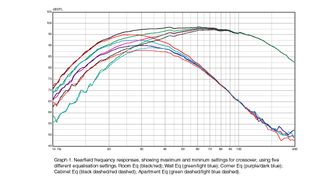
You can see that the flattest and most extended response is returned when the KEF KC62 is set for Room Eq, with the maximum crossover setting being shown by the black trace and the minimum setting by the red trace. You can see that overall, at the maximum setting, the KC62’s response extends from 17Hz to 150kHz ±4dB and between about 23Hz and 100Hz, it’s even more linear, at around ±2dB. These are truly excellent results.
When looking at the other traces on this graph (as well as the traces on Graphs 2 and 3) you need to bear in mind that these traces were measured with the subwoofer in the centre of a room, not in the positions it would be for the relevant equalisation settings. This means that for the ‘Wall Eq’ setting (the green and blue traces), the offset downwards in level that’s evident would be compensated for by the subwoofer’s output being boosted by the proximity of the wall, which KEF’s engineers calculate would elevate the traces to that of obtained in the Room Eq mode.
The same would be true of the Corner Eq (purple and blue traces) and the Cabinet Eq (dashed black and dashed red traces) modes. The traces on Graph 1 that have a completely different appearance are those for the Apartment Eq mode (dashed green and dashed light blue traces) where the low-frequency response has obviously been deliberately rolled off far sooner than for all the other Eq settings.


Graphs 2 and 3 are subsets of the full set of frequency responses that are shown in Graph 1, so you can see the effect of the equalisation more clearly, with Graph 2 showing a set with the crossover at its maximum setting, and Graph 3 a set with the crossover at its minimum setting.
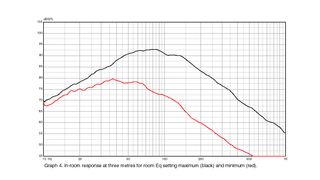
In Graph 4, Newport Test Labs has used a pink noise test signal to measure the KEF KC62’s far-field in-room response, using the Room Eq mode and maximum (black trace) and minimum (red trace) settings of the crossover control. Unlike the other frequency responses, where the subwoofer had to reproduce just a single frequency for each graph point, this test requires the subwoofer to reproduce all frequencies across its pass band simultaneously and is thus an extreme test.
Nonetheless you can see the KC62 still delivered excellent performance, with the response at the maximum crossover setting extending from 35Hz to 180Hz ±4dB and, with the crossover set at minimum, from 15Hz to 100Hz ±4dB. The increased linearity and extension when the crossover is at minimum reflects the reduced workload on the drivers due to the crossover network reducing the level of the high-frequencies.
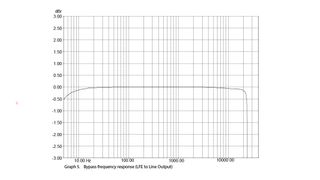
The by-pass frequency response of the KEF KC62 is shown in Graph 5 and you can see that it’s exceedingly flat across the audio band, being just 0.5dB down at 5Hz and about 0.18dB down at 20kHz. However, it appears there is a low-pass filter built in that attenuates frequencies above around 22kHz.
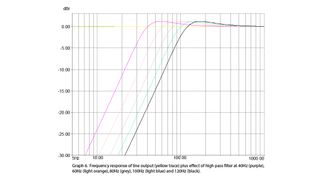
The effect of the KEF KC62’s high-pass filter is shown in Graph 6, with the bypass response without any filtering depicted by the yellow trace. The effect of the filter is shown for all its settings: 40Hz (purple), 60Hz (light orange), 80Hz (light grey), 100Hz (light blue), and 120Hz (black). As you can see, it’s a beautifully designed ‘classic’ high-pass filter.
Newport Test Labs measured the maximum volume level of the KEF KC62 with pink noise test signals as being 98dBSPL at one metre, which was a limit imposed by the KC62’s in-built protection system due to the wideband nature of the test signal. When using a single 80Hz test tone, the KEF KC62 was able to deliver 106dBSPL at the same distance, which is 1dB better than specification.
Australian Hi-Fi is one of What Hi-Fi?’s sister titles from Down Under and Australia’s longest-running and most successful hi-fi magazines, having been in continuous publication since 1969. Now edited by What Hi-Fi?'s Becky Roberts, every issue is packed with authoritative reviews of hi-fi equipment ranging from portables to state-of-the-art audiophile systems (and everything in between), information on new product launches, and ‘how-to’ articles to help you get the best quality sound for your home. Click here for more information about Australian Hi-Fi, including links to buy individual digital editions and details on how best to subscribe.
-
TLe Thank you for the extensive review. The technical aspects of your review are well beyond my knowledge base. I have a LS50W and am considering the KC62. I love the speakers but the bass is slightly lacking. I don't want the boom with subwoofers but I do want a true representation of the bass when one listens to classical, jazz or rock.Reply
So, if I use the KEF controls app along with the LFE setting, will the app optimize for me the crossover? Also, I'm thinking of getting the wireless setup so that I can place my subwoofer in a different part of the living room. Any thoughts on whether there is any discernible difference in quality of sound?
Thanks! -
Mr. Reeee Great, incredibly thorough review! Thank you!Reply
I just picked up a pair of KEF LS60 Wireless speakers to replace my ancient and slowly failing hi-fi system.
After a week? fantastic!
Amazingly open. Articulate. Incredible detail, especially with complex choral (ie: Franco-Flemish polyphony) and orchestral music.
The only downside? Rather meagre bass.
After reading this review, it looks like the KEF KC62 should be the ticket!
I'll probably start with just one…
